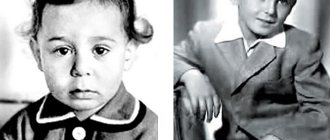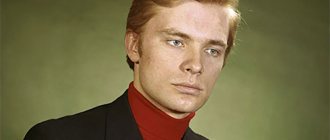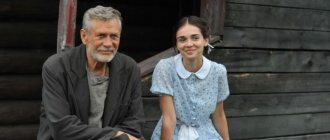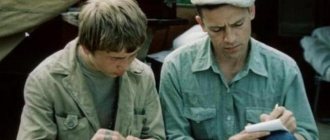Talent, charm, and a gift for comedy are the components thanks to which Semyon Farada achieved success. The biography of the Russian cinema star indicates that he gained fame thanks to the cult film “Garage” by Eldar Ryazanov.
“That same Munchausen”, “Sorcerers”, “Premonition of Love”, “Kill the Dragon”, “Be My Husband”, “Formula of Love” - it is hardly possible to list all the sensational films with Semyon Lvovich. What is the story of a talented actor who, unfortunately, has already left this world?
Actor Semyon Farada: biography, family
One of the most famous comedians of the USSR was born in December 1933. From the biography of Semyon Farada it follows that he was born in Moscow. Lev Ferdman, his father, was a military supply officer responsible for supplying the army with timber. Ida Schumann, Semyon's mother, worked as a pharmacist. The actor had a younger sister, Evgenia.
The first years of Semyon’s life were spent in the village of Nikolskoye near Moscow, where his parents moved shortly after the birth of their son. In 1952, he lost his father, whose cause of death was a stomach ulcer. The mother was forced to raise the children alone, and Semyon helped her as much as he could.
Failed military man
From the biography of Semyon Farada it follows that he studied well at school. Only the boy's behavior left much to be desired. He often disrupted lessons with his jokes, and teachers constantly scolded him at parent-teacher meetings. However, Semyon still graduated from school with a gold medal.
In his teenage years, Farada had no doubt that he would follow in the footsteps of his military father. The young man intended to continue his education at the Stalin Military Academy of Armored Forces.
His dream was not destined to come true. The academy cadets were required not only to have good knowledge, but also to have impeccable physical training, which Semyon did not possess.
Student years
The biography of Semyon Farada shows that he graduated from the power engineering department of the Moscow Higher Technical University named after N. I. Bauman. He managed to enter this educational institution with difficulty, since the prestigious school was extremely reluctant to accept students with a non-Russian surname.
In the essay that Semyon wrote for the entrance exams, 11 errors were “discovered” that did not exist in reality. The young man’s mother filed a complaint with the Ministry of Education, and in the end he was allowed to write another paper and was given a “B” for it.
Farad began participating in amateur performances during his school years. It is not surprising that he continued to perform on stage while studying at the Moscow Higher Technical University named after N. I. Bauman. Semyon openly neglected his studies; due to numerous absenteeism, they even intended to expel him. This did not happen only because the young man was drafted into the army.
Military service
From the biography of actor Semyon Farada it follows that he devoted four years of his life to serving in the navy. His artistic talent made itself felt there too. The young man became the head of the pop group of the Red Banner Baltic Fleet. His performances were invariably a hit with audiences.
One day Semyon took part in a play in which he was given a small role as an anarchist sailor. The aspiring actor received written permission from the military commandant, which gave him the opportunity to wear long hair. Of all the Baltic sailors, only Farada enjoyed such a privilege.
Choosing a life path
When Semyon returned from the army, he brought with him two letters of recommendation. One of them was intended for Arkady Raikin, the other for director Yuri Zavadsky. However, Farada's mother insisted that he graduate from college. Semyon received a diploma from the Bauman Moscow Higher Technical University in 1962. Until 1969, he served as a mechanical engineer at the Ministry of Energy and Electrification.
At the same time, Semyon studied at the variety theater studio at Moscow State University, performed his first “adult” roles and gained experience. By this time, the young man had already realized that the acting profession was his true calling. In those years, he made acquaintance with many prominent personalities, including Gennady Khazanov, Mark Rozovsky, Alexander Filippenko, Mikhail Filippov.
Variety and theater
The studio theater ceased to exist at the turn of the 60s and 70s. Some performances seemed too daring to the authorities, which was the real reason for the closure. The official version said that the actors had already gained experience that did not correspond to the level of the youth studio.
From the biography of Farada Semyon Lvovich it follows that soon after the closure of the studio-theater he was offered a job at the Mosconcert. For several years he played the role of a diploma winner in a pop artist competition. For some time the actor performed in the children's program “ABVGDeyka”. Young viewers liked the sad clown Senya. Farada had to leave the program due to a conflict with the chairman of the State Television and Radio Broadcasting Company Lapin.
Semyon Lvovich received an invitation to the Taganka Theater in 1972. The actor devoted about thirty years to serving there. “The Good Man from Szechwan”, “The Master and Margarita”, “And the Dawns Here Are Quiet...”, “Five Stories of Babel”, “Exchange” are just some of the famous performances with his participation.
Born 12/31/1933, Moscow Real name Ferdman.
Childhood and youth
One of the best comedic actors of Soviet and Russian cinema, Semyon Farada was born on December 31, 1933 in Moscow, in the family of a military man. The real name of Semyon Lvovich is Ferdman.
Semyon's father, adjutant to the chief marshal of artillery troops Lev Ferdman, died early, and the entire burden of raising children (Semyon had a sister) fell on his mother's shoulders. She had a hard time. Although Semyon was an excellent student, he was a real tomboy.
After graduating from school (with a gold medal!) Semyon wanted to follow in his father’s footsteps and enter the Stalin Armored Academy. But his dream was not destined to come true. In addition to good knowledge, it was necessary to have excellent physical fitness - to have at least a second category in athletics.
The documents had to be taken away. The distressed young man took them to the first establishment he came across along the tram. It turned out to be the Moscow Higher Technical University named after N.I. Bauman. It should be noted that, according to an unspoken order “from above,” they tried not to admit students with a non-Russian surname to this prestigious school. But Semyon did it. True, not without adventure.
The young man carefully copied an essay on the topic “Stalin is world peace” from a cheat sheet, but the inspector rejected the essay, finding 11 non-existent errors in it. Then Semyon’s mother went to the Ministry of Education and got the work reviewed! Justice was restored, the young man was allowed to write another essay. He received a “B” and entered the Faculty of Power Engineering.
Craving for the theater
While still a schoolboy, Semyon Farada often took part in amateur performances. He even thought about entering the theater school, but, as already mentioned, the young man chose the Bauman School.
Nevertheless, a craving for theater always lived in Semyon’s heart. At the Bauman School, he continued to participate in amateur performances, so actively that they even wanted to expel him! It was at this time that he was called to serve in the navy. For four whole years.
Semyon Farada showed his artistic talent in the navy. He led the pop group of the Red Banner Baltic Fleet (which actually consisted of him alone) and performed in the drama group at the House of Officers in Baltiysk. In the play he played the small role of an anarchist sailor. For this role, he, the only one of the Baltic sailors, was given written permission by the military commandant of the city to wear long hair.
Semyon Farada returned from the army with two letters of recommendation: to the director Yuri Zavadsky and Arkady Raikin. But, at the insistence of his mother, he graduated from the Moscow Higher Technical School in 1962 and until 1969 worked as a mechanical engineer for boiler plants at the USSR Ministry of Energy and Electrification. In his free time from work, Semyon Farada studied at the variety theater studio at Moscow State University, where there was a wonderful team: Alexander Filippenko, Gennady Khazanov, Mikhail Filippov, Mark Rozovsky...
Variety and theater
At the turn of the 60s and 70s, the studio theater was closed. The official reason was announced that the actors had become masters of the stage, and this now does not correspond to the level of the youth studio. In fact, the authorities simply did not like some of the performances of brave young people.
After the studio was closed, Semyon Farada was invited to work at Mosconcert, where he became a diploma winner at a pop artist competition. During these same years, he was first invited to act in films. It all started with the children's program “ABVGDeyka”, where he played himself - the sad clown Senya. But soon he had to leave the program: the chairman of the State Television and Radio Broadcasting Company Lapin did not like the eagle profile.
In 1972, Yuri Lyubimov invited Semyon Farada to the Moscow Taganka Drama and Comedy Theater. On the stage of this theater over three decades, the actor had the opportunity to play in many performances, including: “The Master and Margarita”, “Exchange”, “The Good Man from Szechwan”, “And the Dawns Here Are Quiet...”... The play is considered one of Farada’s best acting works "Five stories of Babel."
The actor met his love at the Taganka Theater...
Personal life
By the time he entered the Taganka Theater, Semyon Farada had already been married twice. But the actor considers both of those marriages to be an accident. Maria Polizeimako, a hereditary actress (her father is People's Artist of the USSR Vitaly Polizeimako, her mother is the famous Leningrad actress Evgenia Fish), was also married and raised a son from her first marriage.
As Semyon Farada admits, he insisted that Masha give birth to his son (he had no children before). After the birth of Misha, Semyon Farada and Maria Polizeimako got married. This marriage turned out to be long and happy.
Misha grew up, took his mother’s last name, graduated from GITIS and became an actor at RAMT.
Movie
Semyon Farada began acting in films in the late 60s. In 1967, he made his debut in the film “Holidays in the Stone Age,” which is practically unknown today. For the next ten years, Semyon Farada (then still Ferdman) acted occasionally in films of various levels, but, as a rule, in episodic roles.
In one of the films, Valery Akhadov’s film “Forward, Guardsmen,” the actor acquired his famous pseudonym. The fact is that the film was shot at a Tajik film studio, where the actor was made clear that the name Ferdman could not be in the credits. So Semyon Ferdman became Semyon Farada. Moreover, after changing the surname in the passport, he redid the marriage certificate and birth certificates.
By the way, many people put the emphasis in Semyon Farada’s surname on the last syllable, while the actor himself claims that this is a mistake and the emphasis should fall on the second syllable.
The real discovery of film actor Semyon Farada took place in the late 70s. In 1979, two brilliant films were released at once: Eldar Ryazanov’s comedy “Garage”, where the actor played a trumpeter, and Mark Zakharov’s film parable “That Same Munchausen”.
After these films, offers to Semyon Farada rained down like from a cornucopia. Directors mainly used the actor's comedic talent. He starred in such famous films as “The House That Swift Built” and “Kill the Dragon” by Mark Zakharov, “Be My Husband” by Alla Surikova, “Premonition of Love” by Tofik Shakhverdiev, “The Magicians” by Konstantin Bromberg, “A Million in the Marriage Basket” Vsevolod Shilovsky and others. One of the most successful comedic works of Semyon Farada is his role in the ironic melodrama “Formula of Love” by Mark Zakharov. And the song “Uno Momento,” which Farada performed in this film with Alexander Abdulov, became a real movie hit for many years.
The actor himself considers his best film role to be the kind elderly tailor from Ifraim Sevel’s tragicomedy “The Parrot Speaking Yiddish,” filmed in 1990.
In the early 90s, the situation in the country changed seriously. In the new conditions, many low-quality films began to be made. Semyon Farada also happened to participate in some of these films. Among them are “Russian Miracle” and “Russian Business” by Mikhail Kokshenov. Later, Semyon Lvovich admitted that he considered these films his biggest failure.
Disease
In recent years, Semyon Farada has retired from work. The reason for this was a serious illness. The fact is that Semyon Lvovich has a heart defect. Back in 1988, the actor underwent heart surgery with an artificial valve installed. The operation was successful, and for many years Semyon Lvovich felt great and even played football.
Trouble came in 2000. In June, Semyon Lvovich's close friend Grigory Gorin is smart. The next day, Farada suffered a massive stroke and her speech was impaired. The actor underwent treatment at a sanatorium, after which he began to move around the apartment with a cane and talk. But the trials were not over.
A year and a half later, Semyon Lvovich broke his femoral neck. The involuntary cause of the injury was Farada’s favorite dog, a shepherd named Rick, who accidentally knocked out of the artist’s hands the stick with which he was moving around the apartment. Three operations followed and... a new blow - a second stroke.
In recent years, Semyon Lvovich has changed 13 hospitals. During this difficult time for him, the actor is supported by his wife and numerous friends - Vladimir Resin, Efim Shifrin, Gennady Khazanov, Dmitry Kharatyan, Yuliy Kim, Yuliy Gusman. Semyon Lvovich is helped by the theater management, businessmen (Gennady Lazarevsky and Bogdan Maslovets), and ordinary people who remember and love the famous actor.
Filmography:
1967 Holidays in the Stone Age 1976 One fine day 1977 Risk is a noble cause 1978 Duena 1979 Garage 1979 That Same Munchausen 1980 Where the Fish Come from in the Grass 1981 Be My Husband 1981 The Hat 1982 Premonition of Love 1982 The Magicians 1983 The House That Swift Built 198 3 The Canary Cage 1983 The Loop 1984 The Hero of Her Novel 1984 My Friend Ivan Lapshin 1984 Before We Part 1984 The Secret of Villa “Greta” 1984 The Formula of Love 1985 How to Be Happy 1985 After the Rain, Thursday 1985 Insurance Agent 1986 The Voice 1986 Million in the Marriage Basket 1986 Necessary People 1986 From Salary before payday 1986 With open doors 1987 Midshipmen, forward 1987 Wherever you work 1987 Trainers 1987 The Man from the Boulevard des Capuchins 1988 The story of a billiard team 1988 One, two - no trouble 1988 Kill the Dragon 1988 The Frenchman 1989 Entering the Labyrinth 1989 Criminal Quartet 1989 Constellation Kozlotura 1989 Private Detective, or Operation Cooperation 1990 A Parrot Speaking Yiddish 1990 Nipple System 1990 Passion for Vladimir 1991 Seven Days with a Russian Beauty 1991 Bolotnaya Street or the Anti-Sex Remedy 1991 The Year of the Good Child 1991 Childhood Themes 1991 Red Island 1991 Crazy 199 2 Diamonds of the Shah 1992 Womanizer-2 1992 Air Pirates 1992 Sin 1992 Detonator 1992 Noah's Ark 1992 Naked Heart Season 1992 Fandango for the Monkey 1993 All is Calm in Baghdad 1993 Okhlamon 1993 Russian Business 1993 Tuteishia 1994 Tabloid Romance 1994 Ve village trip 1994 Coffee with lemon 1994 Monsieur Robin 1994 Russian miracle 1995 Fatal Eggs 1999 Directory of Death. Buy glasses 2000 Anthology of jokes. The customer is always right 2000 Bremen Town Musicians and Co.
Actors section
Personal life
Thanks to the Taganka Theater, the actor finally arranged his personal life. The biography of Semyon Farada indicates that it was within these walls that he met his love. His chosen one was his charming colleague Maria Polizeimako. The hereditary actress was the daughter of People's Artist Vitaly Politsemako and Evgenia Fish. Maria had a son from her first marriage, but this did not stop Semyon from marrying her.
Farada convinced his wife to give him a son. Before meeting Maria, the actor was married twice, but both of his marriages were childless. A boy was born into the family, who was named Mikhail. Only after this did Semyon and Maria get married.
Personal life of Semyon Farada
Before meeting Maria Politsemako, Farada had already been married twice. However, he himself more than once called these episodes an accident. But a meeting with a young actress from a theatrical family changed his life radically. After a short period of dating, the two young people decided to get married. Their only son was born in the marriage, Mikhail Polizeimako, now also known for his roles in theater and cinema.
Semyon Farada with his wife Maria
First roles
It was not thanks to the Taganka Theater that Semyon Farad became a star. The biography and personal life of the actor became of interest to the public after he began actively working on the set. Semyon Lvovich made his debut in the film “Holidays in the Stone Age,” where he played the cameo role of a tourist. The picture, which was released in 1967, did not make much of an impression on viewers.
“Forward, guardsmen!”, “All the evidence is against him”, “Between heaven and earth”, “Long, long business”, “Risk is a noble cause”, “One fine day”, “Duenna” - films in which the actor performed his first roles.
The Good Man from Szechwan
During this period, a new life began - acting. Semyon went on a free voyage as an artist at the Mosconcert. He earned little money, but was absolutely happy because he could finally devote himself entirely to his favorite business.
His first memorable work was the role of the sad clown Senya from the children's television program “ABVGDEyka”. The program, as they would say now, had fairly high ratings, which ensured its long and successful existence. However, the overly “characteristic” profile of Semyon was not to the liking of the local head of television, Lapin, and Farada was again left out of work...
The subsequent years of wandering brought Semyon only a few cameo roles in films. However, the few that Farad managed to play were noted by the director of the Taganka Theater Yuri Lyubimov, and in 1972 he invited him to join his staff.
Life began to get better. The roles are here. Both in the theater and in the cinema. The peak of his popularity was still ahead: from the late seventies to the mid-eighties, Semyon Farada would act non-stop, but for now fate gave him personal happiness. Semyon met his colleague, Maria Politsemako, heir to the famous acting family. The culmination of their long romance was the birth of a child, Mikhail Polizeimako, and the subsequent wedding. Maria was then 38, and Semyon was almost 43 years old.
The lucky star of Semyon Farada rose on the horizon of Soviet cinema in 1979. Roles rained down on him as if from a cornucopia. Its main characters - the trumpeter from Ryazanov's "Garage" and the commander-in-chief from Zakharov's "That Same Munchausen" - were interspersed with several dozen other roles, less significant, but no less talentedly performed. Semyon Farada became an all-Union recognizable and respected actor. His acting activity did not stop even in the hungry 90s, when the quality of cinema dropped sharply and the style of films released narrowed to one-sided crime comedies. Even during these years, Farada found the strength and opportunity to act in films. These roles hardly brought him satisfaction, but they brought money to the family, and they gave him the opportunity to continue to feel like an actor.
From obscurity to fame
“Garage” is the famous comedy by Eldar Ryazanov, thanks to which Semyon Farad first attracted the attention of the public. The biography and photos of the actor began to arouse keen interest among viewers. He did a brilliant job playing the deadpan trombone player.
In the same year, the fantastic comedy “That Same Munchausen” was presented to the audience, which helped the actor consolidate his success. In this film, Semyon Lvovich plays the role of commander-in-chief.
Movies
At the end of the 1960s, Semyon Farada finally quit his boring job as a mechanical engineer working on boiler systems and began performing at the Mosconcert. Soon the artist becomes a diploma winner at various competitions. In 1972, he was accepted into the troupe of the Moscow Taganka Theater, where Yuri Lyubimov took him.
Semyon Farada as Senya the Clown
This theater, according to Semyon Farada, became his second home. On his stage he played in many productions. The best of them " Master"
and
Margarita
,” “And the dawns here are quiet...” and “Five Stories of Babel.”
But all-Union fame came to the artist after his appearance on the screen. The debut took place not in a movie, but in a television show. Farada played a sad clown in the children's program "ABVGDeyka". Clown Senya brought the actor his first wave of popularity. The cinematic biography of Semyon Farada begins with the little-known films “Holidays in the Stone Age” and “Forward, Guardsmen!”
Semyon Farada in the film “That Same Munchausen”
It was then that the artist’s former surname, dissonant, in the opinion of the management of the films, changed to the one now known to all of us - Farada. Moreover, Semyon Lvovich liked the new surname so much that he decided to take it officially.
Semyon Farada played his first star roles in the late 1970s. First, a trombonist in Eldar Ryazanov’s wonderful comedy “Garage”. Then the commander-in-chief in Mark Zakharov’s tragic farce “That Same Munchausen”
" Farada is becoming really popular.
Semyon Farada in the film "Sorcerers"
In the 1980s, the artist’s film career rapidly gained momentum. “Be My Husband”, “The House That Swift Built”, “Sorcerers”, “Formula of Love”, where Farada in a duet with Alexander Abdulov became the favorites of the entire film public of the Soviet Union.
In the second half of the 1980s, fans of the talent of Semyon Lvovich Farada saw their favorite comedian in the films “After the Rain on Thursday,” “A Million in the Marriage Basket,” “The Man from the Boulevard des Capuchins” and “Kill the Dragon.” The artist’s roles in these films are not the main ones, but it seems that without him these films would have lost a lot.
Semyon Farada in the film “Formula of Love”
The actor himself considered his best and favorite role to be not a comedy, but a dramatic work in the lyrical film “The Parrot Speaking Yiddish.” Farada played the kind, elderly Jewish tailor Khaimovich. It is noteworthy that in this film, released in 1990, the actor’s wife Maria Politsemako played with her husband for the first time. Over 33 years of work in cinema, the “episode genius” Semyon Farada played in 130 films.
Film career
“Garage” and “That Same Munchausen” are films thanks to which Farad became a sought-after actor. The directors offered him mostly comedic roles, which suited him completely. “Kill the Dragon”, “The House That Swift Built”, “The Magicians”, “Formula of Love”, “Be My Husband”, “Premonition of Love” - it is difficult to list all the successful films in which he has starred over the years.
When the actor was asked about his favorite role, he never hesitated to answer. Semyon Lvovich recalled the tragicomedy “A Parrot Speaking Yiddish” by Ephraim Sevel, in which he embodied the image of a kind elderly tailor.
Farada Semyon Lvovich - Biography
Semyon Lvovich Farada (real name Ferdman ; December 31, 1933, Nikolskoye village, Moscow Region - August 20, 2009, Moscow) - Soviet and Russian theater and film actor, Honored Artist of the RSFSR (1991), People's Artist of the Russian Federation (1999).
Semyon Lvovich Farada (Ferdman) was born on December 31, 1933 in the village of Nikolskoye, Moscow Region, which became part of the city of Moscow in 1960 (near the Vodny Stadion metro station), into the Jewish family of Lev Solomonovich Ferdman and Ida Davydovna Shuman, who moved in early 1930 's to study in Moscow from Novograd-Volynsk, Zhytomyr region of Ukraine.
Father, Lev Solomonovich Ferdman (1912-1952), lieutenant of the Red Army, studied at the Forestry Institute in Moscow, worked as a military specialist in supplying the Soviet army with timber in the People's Commissariat of the Forestry Industry of the USSR. After his dismissal from the People's Commissariat in 1948, during the fight against cosmopolitanism, he (already with the rank of major) was transferred to a peripheral military base in Yaroslavl, where he died in 1952 at the age of forty from a stomach ulcer that opened at the front. He was buried at the Vostryakovsky cemetery in Moscow.
Mother, Ida Davydovna Shuman, studied at a pharmaceutical college in Moscow. After her husband left for Yaroslavl, she raised two children alone, Semyon and his sister Evgenia (born 1939; after marriage - Sokolov; since 1992 lives in Israel). Semyon replaced his sister's deceased father. Ida Davydovna died in 1989.
From the age of five, Semyon was friends with Vladimir Resin. They were like relatives. Their families lived in the same communal apartment on Selskokhozyaystvennaya Street in Moscow near the VDNKh metro station for twenty-seven years.
In high school, Semyon studied very well, graduating with a gold medal, went in for sports (football), and participated in theater clubs. His sister Evgenia Sokolova (née Ferdman) talks about his passion for theater:
“... In the 10th graduating class, he took part in a school play based on “The Inspector General.” And then I saw my brother on stage for the first time. He was so natural in the role of either Bobchinsky or Dobchinsky that I was truly scared when his hero, listening at the door, was knocked by this door. And I saw a “broken” nose, actually smeared with paint.”
But there could be no question of Semyon entering a theater university. In a military family, the son should study at a military school - this was the opinion of the parents. He submitted documents to the Military Academy of Armored Forces named after I.V. Stalin. And, of course, I immediately received a turnaround. He was told that due to high blood pressure (this is a football player's!) he was not allowed to take the exams. And Semyon became a student at the Bauman Institute, finding himself the only Jew to enter.
In 1962 he graduated from the Faculty of Power Engineering of the Moscow Higher Technical School named after N.E. Bauman (Moscow Higher Technical School named after N.E. Bauman), receiving the specialty “Mechanical Engineer for Boiler Installations”.
After three years of studying at the institute, he was called up for military service in the Red Banner Baltic Fleet in the city of Baltiysk, Kaliningrad region, where he served for four years. He performed in the drama group at the House of Officers in Baltiysk, and performed a small role of an anarchist sailor in the play based on the play by Soviet playwright Boris Lavrenev “Razlom”. He headed the variety group of the Red Banner Baltic Fleet.
After graduating from the institute, he worked for seven years as a mechanical engineer for boiler installations at the Ministry of Energy and Electrification of the USSR. At the same time, he studied at the variety and theater studio “Our House” in the House of Culture of the Humanities Faculty of Moscow State University on Mokhovaya. After its closure, he worked at the Mosconcert, where he became a diploma winner at a pop artist competition.
Despite his talent and great passion for the theater, Farad never studied acting anywhere in his entire life.
Semyon’s first experience of working on television was the children’s educational television program “ABVGDeyka”, in which he played the sad clown Senya. In the early 1970s, this character brought Farada her first real popularity.
Semyon Farada (then Ferdman) made his film debut in 1967 with the cameo role of a tourist in the film “Vacations in the Stone Age” directed by Semyon Raitburt. In 1971, in the credits of the film “Forward, Guardsmen!” (film studio “Tajikfilm”), where Semyon played the role of a pioneer leader, it was decided to change the “discordant”, according to the management of the film, surname Ferdman to the pseudonym “Farada”. He later officially changed his real surname in his civil passport and other personal documents to Farad's surname.
In 1970-1971 - pop artist.
In 1972, director Yuri Lyubimov invited Semyon Farada, who had no acting training, to work at the Moscow Taganka Drama and Comedy Theater, on the stage of which the actor served for three decades, playing in the plays “The Good Man from Szechwan” (the second God), “Hamlet” "(second gravedigger), "The Master and Margarita" (house manager Bosoy, barman Sokov, entertainer Bengalsky), "Five Stories of Babel" (Zagursky's student) and many others.
In 1975, in the troupe of the Moscow Taganka Drama and Comedy Theater, Farada met the woman of his life, actress Maria Politsemako. She was already a famous artist, Semyon was just taking his first steps on the big stage, and both were not free. She fell in love, wanted to propose, but at the most crucial moment she suddenly set an ironclad condition - to give birth to a son, which she later did, giving birth to the future actor Mikhail Polizeimako in 1976.
The truly “star” roles for Semyon Farada were his bright roles in two brilliant films - the trombonist in the comedy “Garage” (1979) by Eldar Ryazanov and the commander-in-chief in the tragicomedy “That Same Munchausen” (1979) by Mark Zakharov. Since then, the comedic talent of Semyon Farada has been in great demand - offers from directors have poured in one after another. The actor starred in many famous films: “Be My Husband” (1981), The Magicians (1982), “Premonition of Love” (1982), “The House That Swift Built” (1982), “Formula of Love” (1984), “After Rain on Thursday" (1985), "A Million in the Marriage Basket" (1985), "The Man from the Boulevard des Capuchins" (1987), "Kill the Dragon" (1988) and many others.
The actor himself considered one of his best films to be the serious dramatic role of the kind elderly tailor Khaimovich in the lyrical comedy “A Parrot Speaking Yiddish” (1990) directed by Efraim Sevel, and Semyon Lvovich’s partner in the film was his wife Masha.
Over thirty-three years of work in Russian cinema, the master of the film episode Semyon Farada has starred in one hundred and thirty films.
Since 1996, he has headed the acting club “100 Roles” named after Nikolai Kryuchkov.
In 1988, Semyon Farada's health began to deteriorate. Heart problems started. He underwent serious heart surgery - he was given an artificial heart valve.
In June 2000, a week after the funeral of his best friend, writer Grigory Gorin, Semyon Farada suffered a massive stroke, which resulted in speech impairment. Due to damage to a significant part of the brain, the actor was forced to relearn how to walk. Due to health problems, the actor had to leave cinema. A year and a half after the stroke, Semyon Lvovich broke his femoral neck. Three operations followed, and then a second stroke.
Throughout the nine years of his serious illness, the actor was cared for by his devoted wife Maria Vitalievna Politsemako and son Mikhail Politsemako.
On the evening of August 20, 2009, after a serious long-term illness, Semyon Farada died at the age of seventy-five in the Vishnevsky Hospital in Moscow. The cause of death was chronic cardiovascular failure, which developed as a result of the strokes he suffered.
The civil funeral service took place on August 24, 2009 at the Central House of Cinema in Moscow. The actor was buried on the same day at the Troekurovsky cemetery in Moscow.
Disease
In the last years of his life, the famous comedian practically did not appear on the set. The reason for this was a heart defect, as evidenced by the biography of Semyon Farada. The family supported the star as best they could. In 1988, he underwent heart surgery and was fitted with an artificial valve. Semyon Lvovich recovered, felt great and could even have fun playing football.
In 2000, the actor suffered a massive stroke, which resulted in speech impairment. Farada had to undergo a long course of treatment, which allowed him to start talking and moving around the apartment again. A year and a half later, he broke his hip, then had a second stroke. Long-term treatment was again required.
Semyon Lvovich's health deteriorated again in 2009. The talented actor was hospitalized with a diagnosis of pneumonia. His heart gave out on August 20, 2009.
Death
The artist's heart problems began in the late 1980s. Semyon Lvovich underwent surgery - an artificial valve was installed.
In the summer of 2000, the artist suffered a massive stroke: Farada took the news of the death of his best friend Grigory Gorin very hard. After this, further work in the theater and on the set turned out to be impossible: the actor’s speech was impaired and a significant part of his brain was damaged. Having recovered a little, he learned to walk again.
The tragedy happened a year and a half after the stroke. Semyon Farada broke his hip. After the third operation, a second stroke occurred. But thanks to his beloved wife Masha and son, he lived for another 9 years.
Semyon Farada died on August 20, 2009. The actor turned 75 years old. The public's favorite was buried at Troekurovskoye Cemetery.
Son
What else can you tell fans who are interested in the biography and personal life of Semyon Farada? A stroke took the life of a talented actor, but he left an heir.
The son of Semyon Farada and Maria Polizeimako followed in his parents’ footsteps and connected his life with dramatic art. Mikhail successfully graduated from GITIS and took his mother’s last name. He played his first famous role in the comedy “Hello, I am your roof!”, in which provincial businessman Sergei Kaprishchev became his hero.
The film “Money Day” helped Mikhail to consolidate his success, in which he again demonstrated his comedic talent. “Passion for Cinema”, “Three Half-Graces”, “Gloss”, “Radio Day”, “Down House” are other sensational films with his participation.











